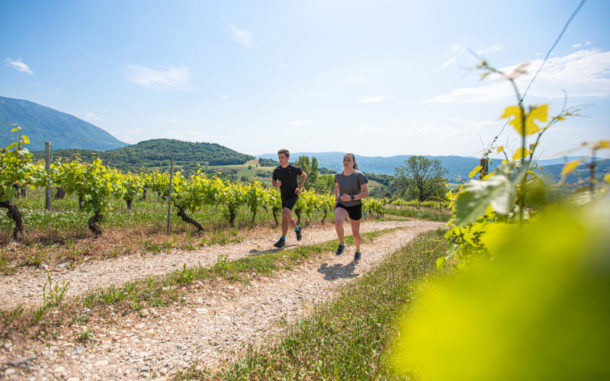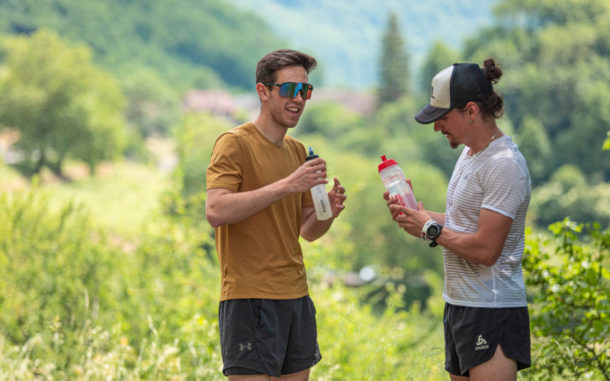
As temperatures steadily climb, summer firmly establishes its presence. Training in this season necessitates some adaptations, particularly concerning training schedules and hydration. Below are our comprehensive tips for training effectively during the summer.
Contents
Should you keep training during the summer?
Deciding whether to continue training during the summer doesn’t have a definitive answer; it hinges on your personal summer plans. If you view summer as a hiatus from rigorous training, it’s perfectly fine to stick to that plan. Use this period for relaxation and rejuvenation, preparing yourself to return in top form for the training recommencement in September. Even during this break, you can engage in light activities like walking or beach volleyball to maintain a level of physical activity.
Conversely, if your agenda includes races or events in the summer or autumn, Coach Arthur will likely advise against a complete training break. He recognizes the need for some leeway, acknowledging that summer brings its unique blend of social events, barbecues, pool parties, and ample sunshine. For those planning to sustain their training regime during this period, we’ve prepared several tailored tips to guide you.
What time of day should you prefer for training?
The intense heat of summer, often with temperatures soaring above 30 degrees Celsius, necessitates careful planning of workout times to avoid the hottest parts of the day. For those who are early risers, scheduling training sessions in the morning, ideally between 6 AM and 9 AM, is advisable. This might mean tweaking your pre-workout nutrition; perhaps eating lighter or waking up earlier to give your body time to digest.
Evening training, post 7 PM, is another option, though its timing depends on your specific region. It’s important to consider that exercising in the evening can potentially disrupt sleep patterns. Physical activity elevates cortisol levels, a hormone that activates the body’s alert mechanisms, delaying the activation of the parasympathetic nervous system which is essential for relaxation and sleep. Therefore, if you’re planning high-intensity workouts, it’s better to schedule them in the morning to energize your day 😉
For activities like long bike rides or mountain excursions, you need to approach the timing differently. Mountains are generally cooler, thanks to their higher altitudes, but it’s still wise to begin your journey around 8 AM and aim to finish by early afternoon. This is also a precaution against the late-afternoon thunderstorms common in mountainous regions during summer.
Hydration: the key to effective summer training

The cornerstone of successful summer training is consistent and adequate hydration. Aim for a minimum intake of 2 liters of water each day. It’s best to distribute this intake evenly throughout the day, rather than consuming large amounts in a single sitting. Also, try to moderate your hydration during meals to avoid excessive water intake at once.
Carrying water during workouts, even for short 1-hour sessions focused on fundamental endurance, is crucial. The increased summer heat can cause you to sweat more, leading to higher fluid loss. Post-exercise, consider opting for carbonated water – it contains sodium and bicarbonates, which are beneficial for recovery.
For practical hydration during training, consider using a belt equipped with a flask holder. This allows for easy access to water without interrupting your activity. For extended sessions, such as long runs or hikes, trail hydration packs are an excellent solution, offering greater capacity and comfort.
Summer: the prime time for trail runners
While summer might bring a slowdown for road runners, it’s the season trail running enthusiasts eagerly await. This time of year offers the perfect opportunity for extended excursions, be it on mountain trails or long bike rides.
To make the most of your summer adventures, it’s crucial to equip yourself appropriately. The mountains are known for their unpredictable weather, so always be prepared for sudden changes. A clear morning sky is no guarantee against afternoon thunderstorms. Packing a waterproof jacket in your trail backpack is a wise precaution.
Hydration and nutrition are key factors to consider. If your trail route includes accessible water sources, refilling your flasks becomes an easier task. It’s advisable to start with at least 1 liter of water, carrying more if you anticipate limited refill points. As for food, the rule is simple: it’s always better to have excess than to find yourself short.
Don’t overlook these essentials: a tick remover, a survival blanket, a pocket knife, and a compact first aid kit. These items are incredibly useful and often forgotten.
Training in summer is not only possible, but it can also be incredibly rewarding. With the right preparation and equipment, you’re all set to embrace the trails this summer.